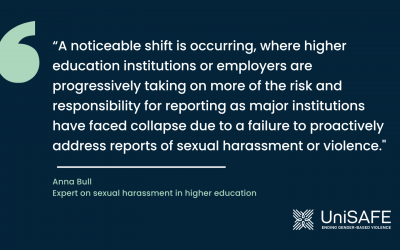By Sofia Strid*
Gender-based violence is a pervasive, persistent and prevalent global problem connected to crime, capital, power, and other hegemons, and a human rights violation. It is an extreme expression of gendered inequalities, a simultaneous cause and consequence of gender inequality, and a form of inequality in its own right (Hearn et al. 2016). It is autotelic, meaning violence begets violence (Schinkel 2010). It includes physical, sexual, economic, material, psychological, and online, as well as online/offline, forms of violence, violations, and abuse, ranging from coercive control, stalking and harassment, to rape and murder (Graaf 2021). Gender-based violence can be symbolic, structural, and systemic (Galtung 1969; Zizek 2008; Strid & Meier-Arendt 2020). It has serious, detrimental, and sometimes deadly consequences for those involved, including victims/survivors, perpetrators, as well as bystanders (WHO 2013; UN 2017).
Gender-based violence is highly prevalent: in the EU, more than half the women (55%) disclose having been subjected to sexual harassment since the age of 15, and one in three women has been subjected to physical and/or sexual violence in their lifetime, according to the EU Fundamental Rights Agency’s Report, the largest prevalence study in the EU to date (n = 42,000). The consequences and costs of the violence per se, and of not handling it, are considerable on individual, organisational, and societal levels (Schneider et al. 1994; Martin-Storey & August 2016). Yet, it is still underreported.
Gender-based violence is a complex, persistent and often unspoken force in many organisations, and universities and research organisations are no exception (Hearn & Parkin 2001; Latcheva 2017). In these contexts, gender-based violence has detrimental effects on the personal health and well-being and scientific careers of managers, employees and students. Many reports and small-scale surveys signal the magnitude of women and men who have experienced gender-based violence within universities and research organisations and show that it is a serious problem specifically for universities and research organisations (McDonald 2012; Anitha & Lewis 2018; Bondestam & Lundqvist 2020ab; SWG GRI 2020). Gender-based violence hinders research and educational (including both teaching and learning) performance, slows down productivity, hampers careers and career development (Johnson et al. 2018), lowers the quality of the work environment and working conditions, ultimately affecting the excellence of research, teaching and learning. Women in precarious working conditions, for example exchange students, PhD students, postdoctoral researchers, and women on temporary contracts, are especially at risk of experiencing gender-based violence and all its consequences. At the same time, they lack a strong support network and the capacity to report.
Universities and research organisations, on the whole, lack sufficient knowledge and policy on gender-based violence. A recent report from the European Research Area and Innovation Committee has clearly shown how none of the EU Member States or Associate Countries has sufficient knowledge, infrastructure, measures and activities in place to estimate the magnitude of gender-based violence, or to fully prevent, protect or prosecute gender-based violence in academia.
The specificity of gender-based violence in universities and research organisations
In addition to the manifestations of gender-based violence we generally observe in society, there can be forms of violence that are specific to the context of universities and research organisations. As a report about harassment against women in Dutch academia suggests, gender-based violence in these contexts may take the form of “scientific sabotage, sexual harassment, physical and verbal threats, denigration, exclusion, and problematising special needs” (Naezer et al. 2019). It concerns both students and different categories of staff, likely affecting different groups to various degrees: younger women, early career researchers, internationally mobile researchers, those with less formal affiliations or short-term affiliations, or those from minority groups (by age, sexuality, ethnicity, etc.) will likely be more vulnerable. Looking at gender-based violence from an intersectional perspective is therefore crucial, as violence can be experienced simultaneously across different grounds, but also aggravated by other forms of diversity. Gender-based violence also plays out differently when it happens between students, between academic and general staff members, and between student and staff. Finally, the stereotype that are usually associated to certain subject-areas can play a role: for example, in STEM disciplines where men’s over-representation often results in very masculine cultures, and where women are not seen as congruent to the stereotypical ‘ideal scientist’, gender-based violence might be more prevalent. This happens because stereotypes influence who is protected, who has influence and who is marginalised (Naezer et al. 2019).
The specific context of higher education affects gender-based violence
Universities and research organisations, especially universities, have a distinct organisational structure with specific implications for gender-based violence: a senior layer of permanent positions, dominated by men; a middle layer of more gender-equal permanent and non-permanent researchers and lecturers, supported by administrative and professional services staff; and a lower level of students, where women tend to outnumber men in a growing number of disciplines. This can create hierarchies of power that are structured by gender and age, and which can underpin violence. The relation between perpetrator and victim/survivor is particularly important to note here. #Metoo showed, with convincing clarity and in agreement with the international research front, that gender-based violence is not only either a form of partner violence or stranger violence (the two perhaps most common understandings of the victims/perpetrators relation), but also a form of “acquaintance violence” or “colleague violence” and “bystander violence” (Chandra & Erlingsdottir 2021).
The structure and culture of universities and research organisations might explain why gender-based violence is an issue. Their environment is unique, but structural inequalities and ‘elitism’ can increase the problem of gender-based violence (Münch 2007). Moreover, there can be a ‘laissez-faire’ attitude that leaves gender-based violence unchallenged by considering that ‘this is just what academia is like’ (Ågotnes et al. 2018). Among staff, the culture of research and higher education is characterised by asymmetric power relations, hierarchical structures and strong dependence on senior staff, toxic masculinity as seen by tendencies towards hypercompetition and individualism. In addition, some staff members are in a more vulnerable position due to short-term contracts or other forms of insecure/precarious employment conditions, and expectations of (international) mobility (Bondestam & Lundqvist 2020a). Among students, there is a tendency to normalise sexism on campuses (Phipps et al. 2018) that can be aggravated when campuses are located in remote or isolated areas. The problem of ‘lad-culture’ and violence at parties has also gained more visibility in recent years (Phipps 2018). There is also a lack of gender perspective in the curriculum, and the culture in the classroom can be one where feminism and gender-related topics are seen at best as irrelevant. Finally, students can experience gender-based violence when conducting fieldwork, or when undertaking an internship.
The responses to gender-based violence in universities and research organisations
It is difficult to understand the full-scale of the problem, as gender-based violence is under-reported, under-researched, and under-estimated in the context of universities and research organisations (Naezer et al. 2019). This happens because victims do not always recognise their experience as violence, but tend to underplay the seriousness of what they have experienced; they might refuse the label of victim, fear not being believed, or even retaliation by their peers or institution. Victims might not speak out as they do not feel that it is safe to, allowing leaders in universities and research organisations to deny that there is a problem, and vice versa (Husu 2001). The response of universities and research organisations to gender-based violence is therefore as important to understand as its prevalence. Responses can originate from different places, such as a dedicated member of staff or via the student union. Complaint systems must provide victims with timely support, and ensure they prevent retaliation and do not engage in victim-blaming (Dobbin & Kalev 2020). Evidence suggests that too often, responses are inadequate as victims do not feel believed, were not offered help, or were discouraged from making a complaint (Naezer et al. 2019). Understanding what factors affect the responses of universities and research organisations also matters: responses may vary depending on the groups involved in the incidents (e.g., it might be easier to tackle incidents between students, rather than those that involve their staff) or when other forms of violence, associated with other grounds of diversity, operate simultaneously to aggravate gender-based violence. What is clear is that the attitudes, knowledge and experience of the leadership in dealing with gender-based violence in universities and research organisations is a key factor.
Making universities and research organisations safe
A main conclusion to be drawn is that despite the growing interest, gender-based violence in academia remains an underdeveloped field of knowledge in the European research area. Despite the political and policy significance, the scale and the social, economic, and health costs, gender-based violence is still under-researched, not least because of the difficulties in measuring its prevalence (Walby et al. 2017; EU 2020)
On the one hand, we seem to know a lot, and on the other we have only just started learning how little we know. While we do know that gender-based violence is prevalent, with serious negative consequences at the individual, institutional and societal level, we do not know how prevalent and we do not know enough about its forms and expressions; we do not know who the perpetrators are, as in their role/position; there are knowledge gaps on the ways in which the intersections of gender and other complex inequalities affect forms, expressions and prevalence; and perhaps above all we know very little about how to best prevent gender-based violence in our workplaces: none of the EU Member States or Associate Countries has sufficient knowledge, infrastructure, measures and activities in place to estimate the magnitude of gender-based violence, or to fully prevent, protect or prosecute gender-based violence in academia (SWG GRI 2020). Further, gender-based violence in universities and research organisations remains largely under-reported (FRA 2014; EIGE 2014), not least because the lack of recognising the experience as violence and due to fear of stigmatisation and perceived re-victimisation if/when reporting.
In conclusion, addressing gender-based violence in universities and research organisations is a crucial endeavour, as it will enable a better, evidence-based and robust understanding of the magnitude of the issue with its various forms and expressions, which in turn creates a baseline for effective policies and measures to be implemented by the organisations. Addressing gender-based violence in universities and research organisations also increases the capacity of staff and students to combat it. As the #MeToo movement has clearly shown, talking about it is the first step to reduce stigmatisation.
Most importantly, without addressing gender-based violence in universities and research organisations, we cannot work towards its reduction in academic environments and research workplaces in Europe. If the very place where knowledge production on gender-based violence takes place is not safe, how can places and organisations that should implement that knowledge be?
*Sofia Strid is Senior Lecturer in Gender Studies at Örebro University (ORU), the scientific coordinator of UniSAFE. ORU will deliver an overall analysis of gender-based violence in academia, based on the datasets and results produced over the project lifetime.
References
Anitha, S. & Lewis, R. (2018). Gender Based Violence in University Communities. Policy, Prevention and Educational Initiatives. Bristol: Policy Press.
Bondestam, F. & Lundqvist, M. (2020a). Sexual harassment in global higher education. A systematic review. European Journal of Higher Education.
Bondestam, F. & Lundqvist, M. (2020b). Efforts to Prevent Sexual Harassment in Academia. An International Research Review. Stockholm: The Swedish Council for Higher Education.
Chandra, G. & Erlingsdóttir, I. (eds) (2021). The Routledge Handbook of the Politics of the #MeToo Movement. London: Routledge.
Graaff, K. (2021). The Implications of a narrow understanding of gender-based violence. Feminist Encounters: A Journal of Critical Studies in Culture and Politics 5(1), 12.
Galtung, J. (1969). Violence, peace and peace research. Journal of Peace Research 6(3), 167–191.
Hearn, J. & Parkin, W. (2001). Gender, Sexuality and Violence in Organizations. Sage publications.
Hearn, J., Strid, S., Husu, L. & Verloo, M. (2016). Interrogating violence against women and state violence policy. Current Sociology 64(4), 551–567.
Husu, L. 2001. Sexism, Support and Survival in Academia. Helsinki: Helsinki University.
Latcheva, R. (2017). Sexual harassment in the European Union: A pervasive but still hidden form of gender-based violence. Journal of Interpersonal Violence 32(12), 1821–1852.
Lewis, R. & Anitha, S., (2019). Explorations on the nature of resistance: Challenging gender-based violence in the academy. Palgrave Studies in Gender and Education. Palgrave Studies in Gender and Education.
MacKinnon, C. (1979). Sexual Harassment of Working Women. A Case of Sex Discrimination. Yale UP.
McDonald, P. (2012). Workplace sexual harassment 30 years on: A review of the literature. International Journal of Management Reviews 14, 117.
Mergaert, L. et al. (2012). Estimation of Girls at Risk of FGM in the EU. EIGE. Luxem.: Pub. Office of the EU.
Mergaert, L. et al. (2016). Study on Gender-Based Violence in Sport. EIGE. Luxem.: Pub. Office of the EU.
Münch, R. (2007). Die Akademische Elit: zur sozialen Konstruktion wissenschaftlicher Exzellenz, Suhrkampf.
Naezer, M., van den Brink, M. & Benschop, Y. (2019). Harassment in Dutch Academia: Exploring Manifestations, Facilitating Factors, Effects and Solutions. Utrecht: LNVH.
Phipps, A. (2018). “Lad culture” and sexual violence against students. In: Anitha & Lewis (eds), Gender Based Violence in University Communities. Bristol: Policy Press.
Phipps, A., Ringrose J., Renold, E. & Jackson, C. (2018). Rape culture, lad culture and everyday sexism: researching, conceptualizing and politicizing new mediations of gender and sexual violence. Journal of Gender Studies 27(1),1–8.
Schneider, K., Swan, S. & Fitzgerald, L. (1997). Job-related and psychological effects of sexual harassment in the workplace. Journal of Applied Psychology 83(3), 401-415.
Schinkel, W. (2010). Aspects of Violence: A Critical Theory. Palgrave Macmillan.
Strid, S. & Meier-Arendt, D. (2020). Violence as system. Journal of Social Medicine 97(2), 235–247.
SWG GRI. (2020). Sexual harassment in the higher education sector. National policies and measures in EU Member States and Associated Countries.
United Nations (UN). (2017). Human Rights Council, Report of the Special Rapporteur on violence against women, its causes and consequences, Rashida Manjoo, A/HRC/20/16.
Walby, S., Towers, J., Balderston, S., Corradi, C., Francis, B., Heiskanen, M., Lombardo, E., Mergaert, L., Strid, S. & Stöckl, H. (2017). The Concept and Measurement of Violence against Women and Men. Bristol: Policy Press.
UN (2017). Human Rights Council, Report of the Special Rapporteur on violence against women, its causes and consequences, Rashida Manjoo, A/HRC/20/16.
World Health Organisation (WHO). (2013). Global and regional estimates of violence against women: prevalence and health effects of intimate partner violence and non-partner sexual violence.
Žižek, S. (2008) Violence. London: Profile.
Ågotnes, K. W., Einarsen, S. V., Hetland, J. & Skogstad, A. (2018). The moderating effect of laissez‐faire leadership on the relationship between co‐worker conflicts and new cases of workplace bullying: A true prospective design. Human Resource Management Journal 28(4), 555–568.



